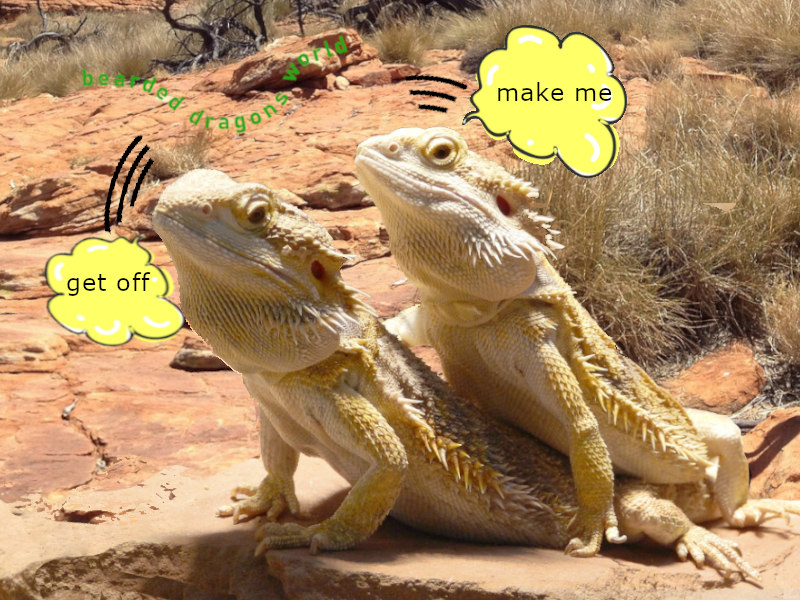
As humans that thrive on friendships and supportive family units it is easy to see how we may also believe bearded dragons get lonely. Whether bearded dragons live together successfully is dependent on numerous factors.
Bearded dragons have cannibalistic tendencies. Larger individuals may attempt to consume smaller ones of their kind. This behavior often results in injuries, especially among young and juvenile bearded dragons, which are frequently kept together in crowded conditions in pet stores or at reptile exhibitions. Injuries, often seen on the limbs, can also happen during feeding times (Raiti, 2012).
Jump To…
Social Networks and Behaviors in Lizards
Bearded dragons live on their own in the wild coming into contact to mate, take on a rivals territory and other interactions. A male holds a large territory that multiple females (who have smaller territories) live within (Wotherspoon, 2007).
Bearded dragons do not live together in the wild, nor do we know them to congregate and socialise in groups in the wild. However, it is possible that they have a social network in the wild and that meeting up may not be accidental.
Ballen et al (2014) conducted a study investigating why social behaviour in reptiles is rare and found this is not necessarily the case at all. Observing the sleepy lizard they found that lizards do not contact each other randomly. They were aware of their neighbours territories and would deliberately socialise with or avoid a particular neighbour. In addition, the individual lizards behaviors played different roles within the social network.
Socialisation as Hatchings & How That Changes Behaviors
We know that bearded dragons hatch into a world without parental care. Hatchlings will disperse from the nest some point after birth, they do not stay in a family unit. However, the time between hatching and dispersing may actually be significant to the bearded dragons well being in the long term and influence how well it interacts with others.
The social lives of reptiles are far more complex than previously thought. Research by Ballen, Shine and Solsson (2014) found that Chameleon’s, also solitary lizards, was able to demonstrate that even brief early life interaction can impact behaviours later in life.
Ballen et al (2014) found that significant differences in the behaviours of those hatched separately than those hatched in groups. Chameleon’s were hatched in isolation and months later introduced to others. Those hatched in isolation were more submissive, would flee, didn’t adopt the same colour changes and were slower at seizing crickets.
Riley et al (2017) did a similar experiment with the tree skink (Egernia striolata) and found that both social interaction and the nature of those interactions have the potential to mold future behaviors. Unlike the chameleon’s, isolating the tree skinks was more likely beneficial with better growth. When kept in pairs one would become dominant. The subordinate lizard was more likely to lose its tail and be less sociable than those reared on their own. Subordinate skinks were more aggressive over time.
Whether the interaction provides positive results as it did for Chameleons or negatives results as with tree skinks, it is clear that the conditions a breeder provides for hatchling has the potential to impact its behavior significantly either short or long term.
2 Bearded Dragons Live Together Until One Fateful Day
When bearded dragons live together they communicate, Some of the communications between bearded dragons are difficult for humans to pick up on. We are wired to pick up on cues such as facial expressions, hand gestures and tone of voice. The cryptic and covert communication of reptiles is what makes it difficult to study (Bels and Russell, 2019).
Communication between bearded dragons is something we tend only to pick up on when it becomes obvious such as a black beard or waving. This means bearded dragons could be signalling to each other, a subtle eye movement or chemical signature left by femoral secretions, but we humans will miss it.
Since we cannot detect these subtle and vital clues, we cannot be confident we can assess whether bearded dragons living together is going well. With little room to move away from a cage mate, disaster can all too quickly occur.
Natosha, female bearded dragon, was kept with her mate. Their owner reported that although the two bearded dragons live together tremendously well for many many years, one day it went terribly wrong. On this fateful day, Natosha’s owner came home from work to find blood around the tank and her foot dangling. The male bearded dragon had attacked the female with no prior warning of the relationship being problematic. Natosha’s foot was amputated.
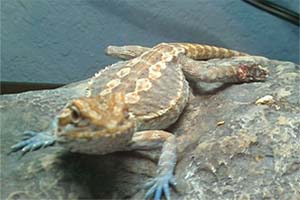
Bearded Dragons Live Together as Hatchlings and Juveniles Until…
Can 2 bearded dragons live together? Pet owners often let bearded dragons live together when they are young. Rearing juveniles together impacts their growth rate and behavior (Riley et al, 2017). Dominance is typically established by size and is common where individuals in clutches are hatching at different times (asynchronously) (Riley et al, 2017) as bearded dragons do.
There is plenty of evidence amongst bearded dragon pet owners that letting 2 juvenile bearded dragons live together will result in one outgrowing the other, at least in small enclosures. Cute gestures of cuddling are more likely signs of dominating the basking resources.
Katniss and Primrose (below) are two juvenile bearded dragons kept together of the very same age. Katniss quickly outgrew Primrose until there was a significant difference in size between them.
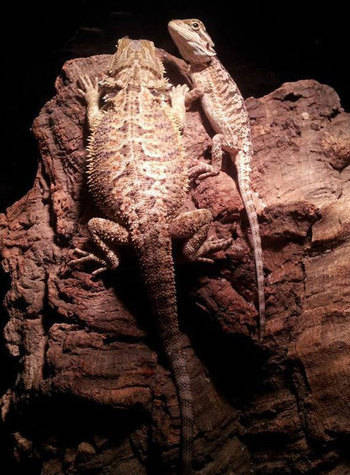
Their owner reported that while these two bearded dragons live together they seemed happy and got along so well. So well that they did everything together. This is normal for juveniles. However, as they grow, behaviors change as with many creatures going through the path to adulthood.
One day, seemingly out of the blue, the largest bearded dragon (Katniss) attacked the smallest, Primrose. Primrose had a broken jaw which could not be set by the vet due to her age (bone density), eye damage was unknown and significant bruising from internal damage.
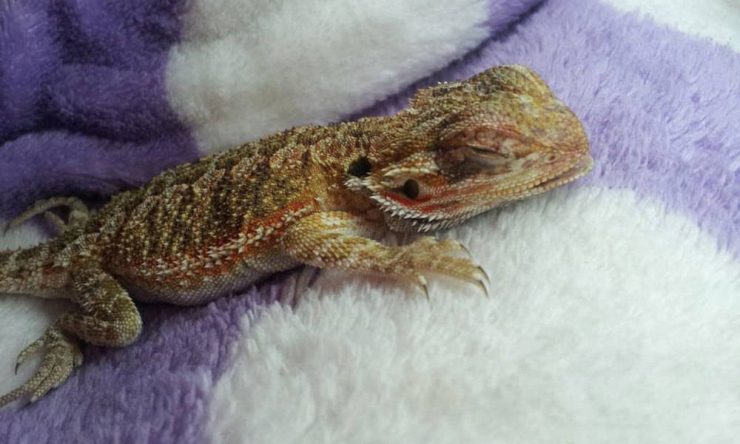
Outside of the physical and psychological stress that an attacked juvenile will experience, there is also the added issue of how the keeper now feels about the aggressor. Keeping bearded dragons together in situations that can turn disastrous also have an impact on the aggressor who may now be seen unfavourably and potentially be out of a home.
In another event, one of our community members did not let their bearded dragons live together. However, they decided to let them see each other. Our community member described how they took their two bearded dragons into the living room. Each was with a handler and they went opposite sides of the room. No sooner had they relaxed their grip when one raced over to the other and immediately attacked. That is an indication of just how fast they can be when they feel the need to deal with another.
Another community member, Tiffany found four bearded dragons live together in terrible circumstances. Kept together since hatching in a small glass tank they each bit off the tails of each other to a point where one was little more than a stump. Eventually rescued by Tiffany and given their own homes. The unnecessary pain and suffering these bearded dragons were put through is distressing to see.
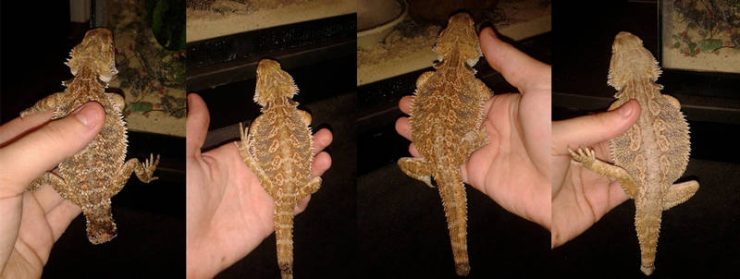
These sort of events are not isolated, they are repeated again and again. Bearded dragons with missing toes and tails is ridiculously common, much of the time is from a cage mate and is really quite unnecessary.
The Bondi Vet (video below) set up a camera to see how this little bearded dragons tail started getting shorter. Can you guess what was doing it?
Dangers of Letting Bearded Dragons Live Together
It is common to hear when bearded dragons live together it can result in serious injury or even death to companions with no warning. Serious consequences of letting bearded dragons live together in inadequate conditions are:
- Stress. Stress is a health issue, it causes disease (i.e. a stress is considered to be a trigger for coccidia, see the post on coccidiosis).
- Mutilation. In many instances tails, toes, feet, legs, eyes or worse are missing or damaged.
- Death: In extreme circumstances, killing their cage mate.
Successfully Keeping 2 Bearded Dragons Together
Bearded dragons live together successfully given the right conditions. Zoos and wildlife parks are great examples of how to successfully keep bearded dragons together. One of the major differences between pet owners and zoos is the size of the enclosures.
There are some benefits in keeping some bearded dragons close to each other. Reproductive disorders are common in reptiles. Keeping a male and female within visual distance of each other, may help prevent preovulatory stasis which can occur whether the female is intended to be mated or not. One likely cause of preovulatory stasis is the lack of cues for stimulating ovulation (Knotek et al, 2017). Other causes include poor husbandry practices such as inadequate lighting and insufficient calcium to develop ova.
Where multiple bearded dragons are housed together there should only be one male in the enclosure. Two or more females can be kept with the male dependent on the size of enclosure.

6 Golden Safety Rules to Protect Bearded Dragons Living Together
Monitoring and watching for behaviours that may indicate the friendship is not going well is not sufficient to protect bearded dragons living together. Even under observation an event can occur quicker than we can respond.
For the best chance of success, some basics need to be applied. Here are 6 golden rules to improve the likelihood of success keeping bearded dragons together:
- Never house males together. Male bearded dragons are more territorial in summer and autumn when they are protecting their breeding rights (Wotherspoon, 2007). Baby or young juvenile bearded dragons reared together or siblings will become rivals as they grow and likely before they hit adulthood. The time to separate is based on size more than calendar age.
- Separate different sized bearded dragons. Smaller bearded dragons are not faring well and need their own resources. Smaller are also likely to suffer far more damage from an attack.
- Keep bearded dragons in large enclosures. Provide large indoor and outdoor enclosures. Four foot tanks are insufficient for one bearded dragon and cannot house more. Young bearded dragons are naturally very active, providing a large enclosure will support natural behaviors. Large bearded dragon housing provides more opportunities to find respite when in danger, lots of basking areas and hiding spots. DIY may be cheaper and provide better results than tanks.
- Provide multiple basking spots and surface area that eradicates the need to compete with each other. Reptiles can notice subtle differences of height and placement of rocks and branches, access to a basking spot that elevates over the others that would escape our attention. Provide multiple basing spots with varying height will allow them to adjust themselves at different heights without competing.
- Provide refuge. Multiple burrows, nooks and crevices with both an inlet and outlet will provide for a hiding place and an exit to prevent being trapped. Hiding places can be made with branches, rocks, vegetation, and so on.
- Prevent competition for food by setting up a feeding program that does not trigger competition for food. Spread the food out allowing them to eat in different spots if needed.
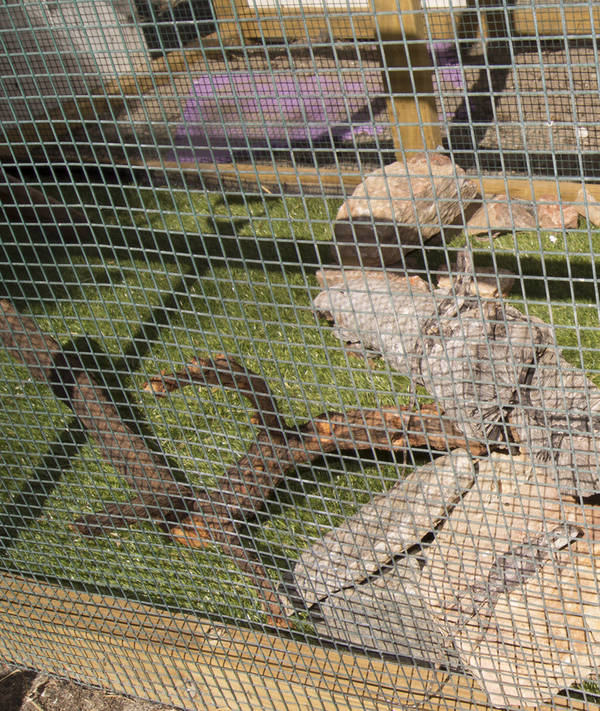
Can Bearded Dragons Live with other Reptiles?
Bearded dragons are best kept on their own are at least only with their own species. Reptiles have very specific environmental requirements and that can result in an inadequate housing setup, temperatures, lighting and humidity for both species.
In addition, bearded dragons can defend their territory and may attack other reptiles or the other reptiles may attack.
Bearded Dragons Live Together Conclusion
Whether a bearded dragon needs a friend or not is difficult to prove scientifically. Much of our knowledge on the subject is based on research with other lizards, behaviors known in the wild and anecdotal evidence.
Social behaviors and interactions are impacted by many factors including diet, incubation temperatures, predation and early social interactions (Riley et al, 2017). These factors also influence bearded dragons, potential friendliness to others or level of aggression.
Although we often see bearded dragons live together, or in close proximity to each, as pets it is not known to be normal in the wild.
In zoos, bearded dragons live together successfully where the environments provided are typically large and well setup with multiple basking and hiding opportunities.
In captivity bearded dragons being kept together in the wrong conditions causes stress and inequitable use of resources such as heating and UVB. This becomes quite apparent as one bearded dragon rapidly outgrows the other.
There are plenty of recounts of stories on how attacks occur between bearded dragons kept together once thought to be friends.
Bearded dragons can live together however, some rules and management are applied to cohabitate safely. Zoos and reptile parks generally offer good models to replicate even if scaled down for domestic situation.
You may be right that your bearded dragon needs a friend. Bearded dragons are sentient beings as are we and we really do not understand their social network nor its impact to their emotional wellbeing. However, unless the necessary conditions for success can be provided, it may not turn out favourably.
Rather than provide a friend, consider that you are your bearded dragons friend. Provide more interaction. Spend time in the sun. Introduce other fun activities such as pools and toys.
More Bearded Dragon Posts
References
- Ballen, C., Shine, R., and Olsson, M. (2014) Effects of early social isolation on the behaviour and performance of juvenile lizards, Chamaeleo calyptratus. Animal Behaviour. Vol 88: 1-6
- Bells, V., and Russell, A. (2019) Behavior of Lizards: Evolutionary and Mechanistic Perspectives. CRC Press
- Bull, C., Gardner, M., Sih, A., and Spiegel, O., Godfrey, S., and Leu, S. (2017). Why Is Social Behavior Rare in Reptiles? Lessons From Sleepy Lizards. Advances in the Study of Behavior.
- Chapple, D. G., and Keogh, J. S. (2006). Group Structure and Stability in Social Aggregations of White’s Skink, Egernia whitii. Ethology. 112: 247-256
- Knotek, Z., Cermakova, E., and Oliveri, M. (2017) Reproductive Medicine in Lizards. Veterinary Clinics of North America: Exotic Animal Practice, Vol 20(2): 411-438.
- Raiti, P. (2012). Husbandry, Diseases, and Veterinary Care of the Bearded Dragon (Pogona vitticeps). Journal of Herpetological Medicine and Surgery, 22(3-4), 117–131.
- Riley, J. L., Noble, D. W. A., Byrne, R. W., and Whiting, M. J. (2017) Early social environment influences the behaviour of a family-living lizard. The Royal Society. 4: 161082
- Wotherspoon, D. (2007) Ecology and Management of Eastern Bearded Dragon Pogona barbata. Western Sydney University Thesis Collection






I feel like my dragon, Havoc, is always very lonely how can I tell that he’s definitely not?
Hi Mischa,
We cannot scientifically prove if bearded dragons get lonely or not. We know in the wild they don’t congregate in lounges of lizards. However, that is not to say that they are not longing to be with others. If your bearded dragon is seriously lonely and pining it would likely eat less, if at all, move less and other typical symptoms of depression in animals. Try putting it in front of a mirror and see how it reacts to its reflection. Be prepared for any reaction when Havoc first notices, it may be mild or quite animated. That may help to assess what Havoc would do if presented with another. If your housing is big enough then you could introduce a 2nd bearded dragon but I wouldn’t recommend it if the cage is 4 foot or less. Providing a big enclosure with lots of natural rocks and branches will provide good enrichment and maybe help.
One outgrew them all and has savagely attacked one of the runts but im trying to nurse it back to health, it wont open its eyes, its barely breathing and im pretty sure those twitches are muscle spasms, should i keep trying and if so what should i do l, or is it a lost cause?
Can you get the younger bearded dragon to the vets? I am sure you have already separated it so now it needs warmth and peace. Hydration is more important than food right now. How old is it? Have you separated the large bearded dragon from the smaller ones?